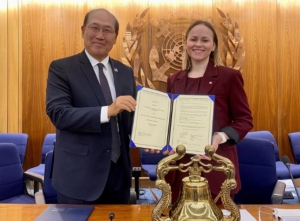GreenVoyage2050. NOK 210 million for the green transformation of shipping in developing countries

By Marek Grzybowski
In September, the Norwegian government committed significant funding to work with developing countries to reduce greenhouse gas emissions from shipping. NOK 210 million was transferred to the International Maritime Organization for the second stage of the IMO GreenVoyage2050 project.
The project is financed by the Norwegian Ministry of Climate and Environment under an agreement between Norway and the IMO. The latest tranche was transferred on September 28 this year, i.e. on the day we celebrate World Maritime Day. It took place during the IMO-UNEP conference – Norwegian Innovation Forum.
– Norway is committed to providing developing countries with the necessary support and resources to make progress towards their emissions reduction targets. We believe that the work undertaken by IMO to support developing countries is extremely important and we are pleased that our further contribution will be a continuation of the work undertaken under the GreenVoyage2050 project, said Ragnhild Sjoner Syrstad, Secretary of State at the Norwegian Ministry of Climate and Environment after the transfer of the next tranche funds for the IMO GreenVoyage2050 program.
New technologies for developing countries
It is emphasized that “One of the important goals of GreenVoyage2050 is to stimulate global efforts to create demonstrators and test technological solutions that help reduce greenhouse gas emissions.”
Private sector participation is achieved by strengthening the existing Industry Alliance to Support Low Carbon Shipping with new partners from the maritime sector. “Partnerships under ongoing programs are also being considered to leverage the results of such programs to encourage the progressive introduction of zero- and low-emission shipping solutions in developing countries,” says the IMO.
The GreenVoyage2050 project has been implemented by the International Maritime Organization for almost 4 years. IMO works with selected developing countries around the world. It focuses on cooperation with small island developing states (SIDS – Small Island Developing States) and least developed countries (LDC – Least Developed Countries).
The aim: reduce greenhouse gas (GHG) emissions
– The extension of this project until the end of 2030 will ensure that developing countries are supported in their transition to marine decarbonisation in line with the IMO Greenhouse Gas Strategy 2023. Norway’s continued support will enable us to build on the significant progress already made under the GreenVoyage2050 project in developing countries and further stimulate efforts [to decarbonize shipping in these countries – Ministry of Economy] – said IMO Secretary General Kitack Lim after signing an agreement with Norway to transfer the next tranche of funds.
The aim of this cooperation and direct financial support for a number of initiatives is to reduce greenhouse gas (GHG) emissions from various types of shipping. Therefore, this initiative is based on cooperation with the maritime business of highly developed countries, international associations focused on environmental protection and other UN agencies, as well as industries generating innovative shipping solutions that contribute to the development of zero-emission shipping.
“This significant funding [from the Norwegian Government – MoE] facilitates the extension of the project beyond phase one, which will end in December 2023,” emphasizes the IMO and states that “In phase two, the project will continue to provide support to developing countries to help them in meeting their climate change commitments and ship energy efficiency targets, in line with the levels of ambition set out in the IMO Greenhouse Gas Strategy.
This is an important part of the activities adopted in July this year. IMO strategy for 2023 towards reducing greenhouse gas emissions from shipping. Active implementation of tasks in both developed and developing countries is important, considering that the IMO has set itself a very ambitious goal of achieving net zero greenhouse gas emissions by 2050.
